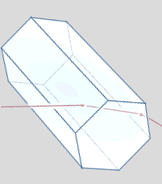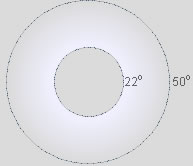
OPOD
What's New
Rays & Shadows
Water Droplets
Rainbows
Ice Halos
Contents
Crystals
Frequent Halos
22° circular
Formation
Disk in the sky
Random xtals?
Moon Halos
More Images
Sundogs
Tangent Arcs
Circumscribed
Pillars
Circumzenithal
Circumhorizon
Parhelic Circle
Infrequent Halos
Multiple Displays
Other Worlds
Observing Halos
HaloSim
High Atmosphere
Links & Resources
Search - Index
123456789012345678
| 22° Halo Formation |
 |
 |
 |
 |
 |
 |
22º halo ray path through a poorly aligned hexagonal prism crystal. Rays pass through faces inclined at 60° to each other. The poor orientations form the circular halo. | Rays
are deflected through many different angles. Mouse over the slider
to see how the refraction changes as the crystal rotates *.
Find the minimum deflection of 21.7º for red light. This occurs when the refraction at each face is the same and the inner ray is parallel to the intermediate crystal face. Rock the crystal back and forth around this position ~ notice how many rotational positions produce deflections close to the minimum. These rays all contribute to the halo's bright inner region. |
| Ray deflections |
Rays passing through two prism side faces inclined 60° to each other are deflected through angles from 22° up to 50°. |
 The 22º halo extends from 22º out to 50º - a disk with a hole - but it is brightest at the inner edge |
||||||
| Minimum deviation |
Most
rays are deflected through angles near to 22° to form the bright
inner edge of the halo. This is a common "minimum deviation" effect which operates in halo and rainbow formation. Rays cluster together near to the angle where they are deviated least**. Minimum deviation rays are symmetrical, they enter and leave the crystal at the same angle and the ray crossing inside the crystal is parallel to a prism face. Rays deviated more strongly produce the outer halo light which fades away with increasing angular distance from the sun until it is undetectable. |
|||||
| No light inside 22º |
No light is refracted through smaller angles and so the area inside the halo is dark - a 'hole in the sky'. † |
|||||
| Origin of colours |
Red light is refracted less strongly than other colours and so the halo's inner edge is red hued sometimes tapering away through oranges and yellows to blue. All but red are indistinct and washed out because they overlap considerably. |
|||||
| |
Crystal shapes |
The actual crystal shapes responsible for the halo are uncertain. As crystals drift downwards in clouds the drag forces tending to align them are strong. It is difficult to explain how ordinary plates or long columns could be so poorly oriented to be able to form this halo. Intermediate length equidimensional prisms would more likely be poorly oriented but they are not very common. They are not found in any great numbers when crystals are sampled during halo displays. Large imperfect columns and/or clusters of columns might produce most everyday 22° halos, suggests Walter Tape‡. However, the crystals responsible for the finest and most colourful 22° halos are still not positively known. The most common of the halos is perhaps the least understood! |
 Column clusters Photo ©Walter Tape, shown with permission |
* |
The diagram is accurately computed for rays of 650nm wavelength (red) and 400 nm (purple) passing through an ice crystal. At each surface a ray splits into partially reflected and partially refracted rays. The exact split depends on the angle of incidence. For clarity the diagram shows only the components contributing to the 22º halo. |
|
| ** | There are other factors. The fraction of the ray transmitted depends on the angle of incidence. The width the beam which can pass through the crystal is also greatest at the angle of minimum deviation. However, the largest effect is that the rate of change of deflection with prism rotation is smallest at the minimum deviation angle - thus more rays concentrate there. | |
| † | Some rays pass undeflected through opposite faces of the prism but they are, of course, indistinguishable from the sun's glare. | |
| ‡ | See "Atmospheric Halos" by Walter Tape. |